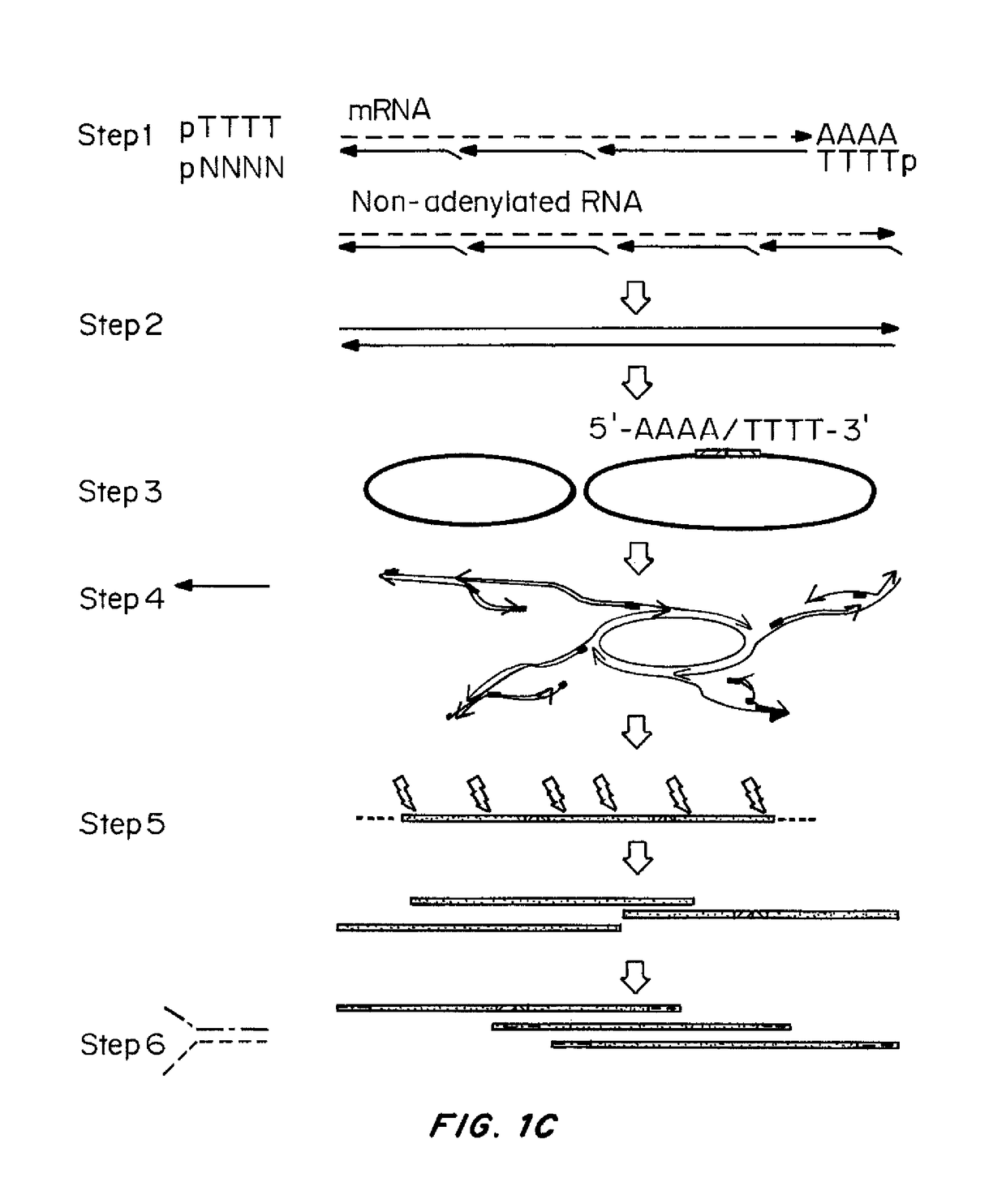Methods for preparing cDNA from low quantities of cells
a cdna and low quantity technology, applied in the field of amplifying cdna libraries, can solve the problems of long mrnas that cannot be given complete sequences, and achieve the effects of reducing contamination, enhancing rna collection, and reducing contamination
- Summary
- Abstract
- Description
- Claims
- Application Information
AI Technical Summary
Benefits of technology
Problems solved by technology
Method used
Image
Examples
example 1
d Development of Methods for Preparing cDNA Libraries from Very Limited Cellular Material
Materials and Methods
[0143]Specific experiments and the materials and methods used therein are described in the additional Examples below. A general description of the principles of the methods follows.
[0144]Methods were developed for preparing cDNA libraries for high throughput sequencing that required very limited cellular material and represented the full length of all cDNA molecules. A procedure for cDNA generation was created using a thermostable reverse transcriptase for the generation of cDNA. First strand synthesis was carried out at 50° C., below the upper temperature limit for efficient reverse transcription, in an effort to minimize effects of RNA secondary structure on the elongation of cDNA. Unless otherwise noted, the single strand cDNA (sscDNA) was converted to double-stranded form (dscDNA) by standard procedures; double strand or single strand cDNA are circularized for PMA, and d...
example 2
n of PMA and SMA
Materials and Methods
[0156]Total RNA Preparation and mRNA-Selective RT
[0157]TempAssure PCR-8-tube strip, a 0.1-mL thin-well PCR tube strip with individually attached dome caps (catalog no. 1402-2900; USA Scientific) was used for all multistep reactions in this project. A protocol was adapted from the kit RNeasy Plus Micro (catalog no. 74034; Qiagen), and using the gDNA eliminator spin column before the RNeasy Minelute spin column for RNA purification. The RNA carrier provided in the kit was always added to the RLT-plus lysis buffer before homogenizing the cells. Finally, the total RNA was eluted with 14 μL 0.1×TE, and ˜12 μL RNA was obtained.
[0158]For the test with various aliquots from bulk extracted total RNA, the total RNA was prepared from 5×105 cells using RNeasy Plus Micro kit (Qiagen) without carrier RNA. A single-tube protocol without physical purification of RNA for RT and Phi29-mRNA amplification (PMA) worked efficiently in cDNA generation, but the genomic ...
example 3
hs of Transcripts were Covered Over their Full Lengths
Materials and Methods
[0192]Alignment
[0193]RNA sequencing (RNA-seq) reads were aligned to the HG19 genome using TopHat (v2.02). Base-level quantitation of genes and genic features were derived using BEDTools and the RefSeq reference transcriptome, as well as the R-make RNA-Seq analysis package (http: / / physiology.med.comell.edu / faculty / mason / lab / r-make / ).
Results
[0194]After sequencing, reads were mapped to the human genome (hg19) using TopHat (Trapnell, et al., Nat Protoc. 7(3):562-578 (2012)). The result demonstrated that, in general, all lengths of transcripts were covered over their full lengths. Some of the results are shown in Tables 4-6.
[0195]
TABLE 4Reproducibility of PMAPMA-PMA-PMA-PMA-PMA-PMA-Sample IDt1t2h1h2k1k2PMA-t11.0000.7150.3440.5790.5940.511PMA-t20.7151.0000.5610.3150.7190.704PMA-h10.3440.5611.0000.7130.8540.813PMA-h20.6790.8160.7131.0000.8560.847PMA-k10.5940.7190.8540.8561.0000.927PMA-k20.5110.7040.8130.8470.9271.00...
PUM
| Property | Measurement | Unit |
|---|---|---|
| temperature | aaaaa | aaaaa |
| temperature | aaaaa | aaaaa |
| temperature | aaaaa | aaaaa |
Abstract
Description
Claims
Application Information
 Login to View More
Login to View More - R&D
- Intellectual Property
- Life Sciences
- Materials
- Tech Scout
- Unparalleled Data Quality
- Higher Quality Content
- 60% Fewer Hallucinations
Browse by: Latest US Patents, China's latest patents, Technical Efficacy Thesaurus, Application Domain, Technology Topic, Popular Technical Reports.
© 2025 PatSnap. All rights reserved.Legal|Privacy policy|Modern Slavery Act Transparency Statement|Sitemap|About US| Contact US: help@patsnap.com



